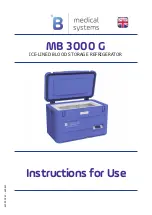
11
2.4 Intended Use
2.4.1. Intended purpose
Ice-lined blood storage refrigerators are devices intended to be used in the blood transfusion medicine
for the support on the diagnosis, prevention and treatment of diseases or injuries by keeping whole
blood or blood components at a protective and stable temperature between 2°C to 6°C until they are
ready for use. The devices comprise an icelined compression cooling system and an integrated alarm
system that warns against unexpected temperature excursions and power failures.
2.4.2. Intended target population
Pharmacists, doctors, laboratory staff or other staff that are trained and/or experienced in dealing with
whole blood and blood components.
The Ice-lined blood storage refrigerators must be operated by individuals in organizations that have the
knowledge of the relevant FDA, AABB, EU or any other applicable regulations on storage and distribu-
tion of blood and blood components. The organization must implement and validate procedures for the
storage and distribution of blood and blood components according to these regulations, including the
necessary storage temperature and the suitable storage period.
Service technicians with a recognized license or certificate as required by local authorities for installa-
tion, servicing and repair of refrigeration systems and equipment, and properly trained on the ice-lined
blood storage refrigerators.
Patients do not come into direct contact with the refrigerators.
2.4.3. Intended use environment
The Ice-lined blood storage refrigerators are stationary type devices and are intended to operate indoors
in hospitals, blood donation services, blood transfusion centers and clinical laboratories.
The devices are designed for an ambient temperature range from +10°C to +43°C under operation, and
from -30°C to +55°C during transport and storage. The ambient humidity range during transport, stor-
age and operation lies between 5% and 95%.
The devices must not be used outdoors.
2.4.4. Indications
The Ice-lined blood bank refrigerators are intended for the safe storage of whole blood and blood com-
ponents used in the clinical medicine for diagnosis, prevention and treatment of diseases or injuries.
Whole blood, red cells, and other blood components intended to be used for transfusion, like leucocyte-
depleted whole blood and red cells, must be kept at a controlled temperature between 2°C and 6°C dur-
ing storage and can be stored for a period of time of up to 35 days, depending on the
anticoagulant/preservative solution used.
Long storage of whole blood and blood components above 6°C increases the risk of bacterial contami-
nation (septicemia), which may progress to septic shock. Septic shock has a death rate as high as 50%,
depending on the type of organism involved, and therefore requires urgent medical intervention.
The storage of blood and blood components below 2°C increases the risk of rupture of the red cells
(haemolysis).
During a maximum transit time of 24 hours, the temperature of whole blood or other blood components
must at no time 10°C. Temperature excursions above +10°C increases the risk of sepsis due
to bacterial contamination.
Blood components intended for intrauterine and exchanged transfusion (e.g. IUT, ET, PR/ET) must be
stored between 2°C and 6°C for no longer than five days prior to use. After concentration and irradia-
tion, the storage time must be no longer than 24 hours.
Содержание MB 3000 G
Страница 1: ...820 9505 61 ed0821 Instructions for Use MB 3000 G ICE LINED BLOOD STORAGE REFRIGERATOR...
Страница 2: ...2...
Страница 3: ...3...
Страница 6: ...6 1 Model Overview Group Model name Ice lined Blood storage Refrigerators MB3000G...
Страница 31: ...31...
Страница 32: ...B Medical Systemes S r l op der Hei 17 L 9809 Hosingen Luxembourg...












































